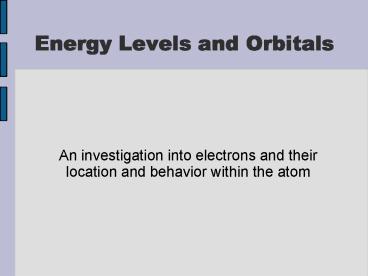Energy Levels and Orbitals - PowerPoint PPT Presentation
1 / 26
Title:
Energy Levels and Orbitals
Description:
If an electron absorbs energy, it may jump to a higher energy level. ... Electromagnetic Spectrum. Types of Radiation. Gamma rays: cosmic radiation, very high energy ... – PowerPoint PPT presentation
Number of Views:34
Avg rating:3.0/5.0
Title: Energy Levels and Orbitals
1
Energy Levels and Orbitals
- An investigation into electrons and their
location and behavior within the atom
2
Exciting electrons...
- If an electron absorbs energy, it may jump to a
higher energy level. - When an electron is at a higher energy level we
say that the electron is in its excited state. - When the electron releases energy in the form of
radiation, we say that the electron has returned
to its ground state. - The type of radiation that is emitted depends on
the amount of energy released.
3
Wavelengths and Energy
- E hc
- ?
- Energy hc two constants
wavelength - This equation shows that larger wavelengths
indicate lower energy and smaller wavelengths
indicate higher energy. - From this information, we can conclude the
relative energies of the electrons returning from
their excited state.
4
Electromagnetic Spectrum
5
Types of Radiation
- Gamma rays cosmic radiation,
- very high energy
- Ultraviolet rays (UV) solar radiation,
- high energy
- Infrared rays (IR) thermal radiation, remote
controls, low energy - Microwave rays microwave oven,
- very low energy
6
Types of Radiation
- Visible Light
- wavelength is in the range of 400 to 700
nanometers (4 x 10-7 meters) - ROY G. BIV
- White light is made of all the colors of light
7
Energy Levels and Spectra
Energy Level Change
Spectra Emission
- 2 --gt 1 Ultraviolet
- 3 --gt 1 Ultraviolet
- 4 --gt 1 Ultraviolet
- 3 --gt 2 Visible Red
- 4 --gt 2 Visible Blue/Green
- 5 --gt 2 Visible Blue
- 4 --gt 3 Infrared
8
The Bohr Model
- According to Niels Bohr, an electron can circle
the nucleus in orbits of only certain distances
from the nucleus. - These orbits are called energy levels.
- An electron cannot be in-between energy levels
(i.e. it is either on the first level or the
second). - Therefore, energy we say is quantized.
9
The Bohr Model (excitation)
1st Energy Level
4th Energy Level
Energy Coming In!
Nucleus
3rd Energy Level
2nd Energy Level
10
The Bohr Model (emission)
1st Energy Level
4th Energy Level
Energy emitted (ultraviolet light)
Nucleus
Energy emitted (red light)
Energy emitted (infrared)
3rd Energy Level
2nd Energy Level
11
The Bohr Model (alternate emission)
1st Energy Level
4th Energy Level
Energy emitted (ultraviolet light)
Nucleus
Energy emitted (blue/green light)
3rd Energy Level
2nd Energy Level
12
Quantum Mechanics
- Energy emission and absorption from elements like
hydrogen led to scientists attempting to explain
why
13
Using the Quantum Mechanical Model
- Quantum mechanics is a mathematical way of
describing where electrons are located. - It is based on the probability of finding an
electron in the space outside the nucleus.
14
First Quantum NumberEnergy level (n)
- Each energy level is farther away from the
nucleus. - Electrons are attracted to the nucleus, so they
will fill the lower energy levels first!
15
Second Quantum Number Subshell (l)
As the energy levels increase, so do the number
of subshells that are needed to cover all the
space around the atom. The first energy level
(n1) has 1 subshell (s) The second energy level
(n2) has 2 subshells (s p) The third energy
level (n3) has 3 subshells (s, p, d) The
fourth energy level (n4) has 4 subshells (s, p,
d, f)
16
Extension
- How many subshells would be present in energy
level 5? - Answer 5!
- s, p, d, f, and g
- How many subshells would be present in energy
level 6? - Answer 6!
- s, p, d, f, g, and h
17
Subshells
- s orbital sphere
- p orbital peanut
- d orbital double peanut
- f orbital flower
18
Nucleus
1s orbital
2s orbital
2p orbital
3s orbital
3p orbital
19
3d orbital
4s orbital
20
Third Quantum NumberAtomic Orbitals ( ml )
- s has 1 orbital orientation (just s)
- p has 3 orbital orientations (px, py, pz)
- d has 5 orbital orientations (dxy, dxz, dyz,
dz2, dx2-y2)
- f has 7 orbital orientations (too complex to
list)
21
Third Quantum NumberAtomic Orbitals ( ml )
- g would have _______ orbital orientations.
- h would have _______ orbital orientations.
22
There is 1 s orbital
There are 3 p orbitals
There are 5 d orbitals
There are 7 f orbitals
23
(No Transcript)
24
(No Transcript)
25
Fourth Quantum Number Electron Spin ( ms )
Each electron can be spin up (1/2) or spin down
(-1/2)
No two electrons in the same orbital orientation
can have the same spin. What is the maximum
number of electrons that can be in the same
orbital orientation at the same time?
26
(No Transcript)

